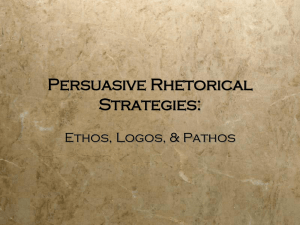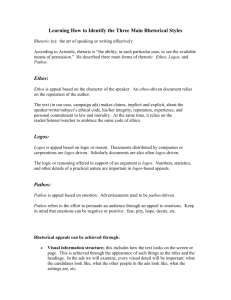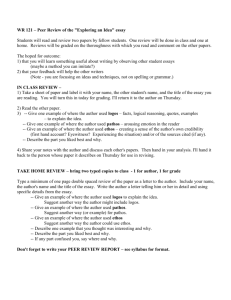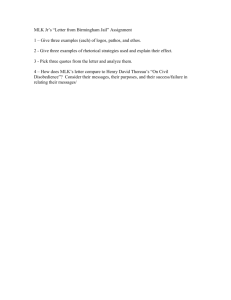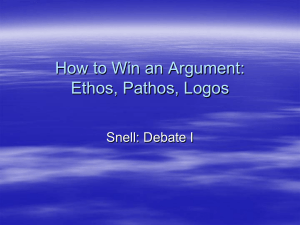Ethos, Logos, Pathos and Mythos: Adding Mystery to Rhetoric for
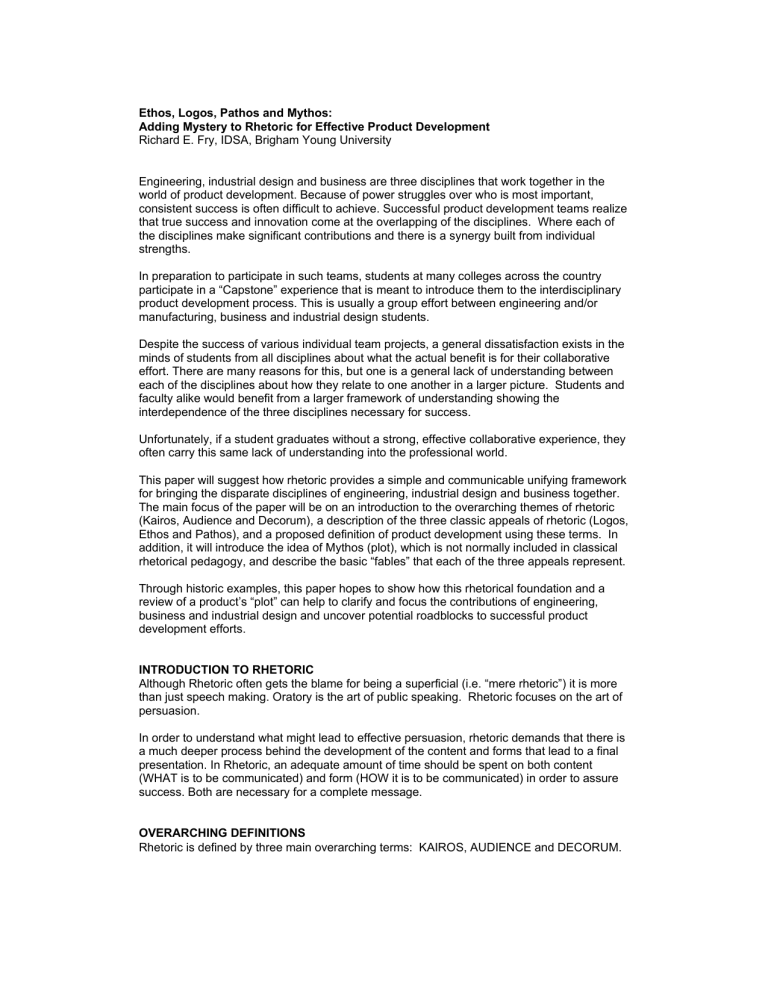
Ethos, Logos, Pathos and Mythos:
Adding Mystery to Rhetoric for Effective Product Development
Richard E. Fry, IDSA, Brigham Young University
Engineering, industrial design and business are three disciplines that work together in the world of product development. Because of power struggles over who is most important, consistent success is often difficult to achieve. Successful product development teams realize that true success and innovation come at the overlapping of the disciplines. Where each of the disciplines make significant contributions and there is a synergy built from individual strengths.
In preparation to participate in such teams, students at many colleges across the country participate in a “Capstone” experience that is meant to introduce them to the interdisciplinary product development process. This is usually a group effort between engineering and/or manufacturing, business and industrial design students.
Despite the success of various individual team projects, a general dissatisfaction exists in the minds of students from all disciplines about what the actual benefit is for their collaborative effort. There are many reasons for this, but one is a general lack of understanding between each of the disciplines about how they relate to one another in a larger picture. Students and faculty alike would benefit from a larger framework of understanding showing the interdependence of the three disciplines necessary for success.
Unfortunately, if a student graduates without a strong, effective collaborative experience, they often carry this same lack of understanding into the professional world.
This paper will suggest how rhetoric provides a simple and communicable unifying framework for bringing the disparate disciplines of engineering, industrial design and business together.
The main focus of the paper will be on an introduction to the overarching themes of rhetoric
(Kairos, Audience and Decorum), a description of the three classic appeals of rhetoric (Logos,
Ethos and Pathos), and a proposed definition of product development using these terms. In addition, it will introduce the idea of Mythos (plot), which is not normally included in classical rhetorical pedagogy, and describe the basic “fables” that each of the three appeals represent.
Through historic examples, this paper hopes to show how this rhetorical foundation and a review of a product’s “plot” can help to clarify and focus the contributions of engineering, business and industrial design and uncover potential roadblocks to successful product development efforts.
INTRODUCTION TO RHETORIC
Although Rhetoric often gets the blame for being a superficial (i.e. “mere rhetoric”) it is more than just speech making. Oratory is the art of public speaking. Rhetoric focuses on the art of persuasion.
In order to understand what might lead to effective persuasion, rhetoric demands that there is a much deeper process behind the development of the content and forms that lead to a final presentation. In Rhetoric, an adequate amount of time should be spent on both content
(WHAT is to be communicated) and form (HOW it is to be communicated) in order to assure success. Both are necessary for a complete message.
OVERARCHING DEFINITIONS
Rhetoric is defined by three main overarching terms: KAIROS, AUDIENCE and DECORUM.
Kairos is defined as the opportunities of the moment. It is a type of time. It is contrasted to
Chronos (quantitative time), and Chaos (lack of time) and has more qualitative implications.
Audience refers to the fact that in all acts of persuasion, there is a specific target group of listeners that come with their own set of unique requirements and biases. The concept of
Decorum highlights the higher probability of success when the content of the message is tailored to the specific needs of the audience. Decorum is about being appropriate.
These three terms, when taken together, provide the following general description of the goal of Rhetoric:
“The speaker, sensitive to the contingencies of the moment, tailors words to specific contexts and audiences towards some discernable result or effect.” (Burton, 2007)
In order to achieve this goal (i.e. persuading an audience towards a particular opinion), the rhetorician relies on three main methods of appeal – LOGOS, ETHOS and PATHOS.
LOGOS is the appeal to Logic; ETHOS is the appeal to character or credibility; and PATHOS is the appeal to emotion. All three need to be present in order to maximize the opportunity for success.
RHETORIC AS A DEFINITION OF PRODUCT DEVELOPMENT
Rhetoric is the act of persuasion. Many industrial designers will tell you the same thing about product development.
The three overarching components of rhetoric (Kairos, Audience and Decorum) clearly apply to the product development process. Restated in terms of product development rather than rhetoric, the above description provides a good working definition of product development:
Successful product development is a process that, sensitive to the constraints of the project (price, materials, distribution, manufacturing process, user preferences, etc), develops products for a specific user group or context (age, lifestyle, user preference, aspirations) towards some discernable result or effect (purchase of the product, increased safety, decreased manufacturing costs, etc.).
In order to accomplish this, all three of the classic appeals of logos (logic), ethos (character), and pathos (emotion) are needed. In translating the idea of rhetoric to product development, the three classic appeals can be described in various ways. They might be most familiar in the words Function , Value and Form . Or, as some others have described (d.school 2009),
Technology, Business and Human Values .
Logos, or Logic coincides with Function. This is under the main control of the technology disciplines – engineering and manufacturing. This is the aspect that is needed to make something work.
Ethos, or Character, is analogous to Value. It can also be thought of as “brand.” This is the character of the company providing the good or service. It is the relationship between the customer and company. Marketing is the traditional champion for this part of the equation.
Pathos, or Emotion, can be linked with Form and is related to the appearance or product aesthetic. Industrial design has primary responsibility for creating a form that is appropriate to the context of a given product.
These are simplified stereotypes of the basic components of product development, but they provide a level of clarity that leads to a better understanding of the overarching goals of the product development process.
Each group—engineering, industrial design and business—has primary ownership of one of the three main appeals of the product development argument. However each area must still deal with the demands of the other areas. For example: within Pathos (the primary area of the industrial designer) there are still issues of Logos (Function) and Ethos (reinforcing
Brand). Does the form contribute to the usability of the product (Logos)? Can the form of the product actually be manufactured (Logos)? Does it reinforce the message and goals of the
Brand (Ethos)? Similarly, within Logos (the primary area of the engineer), there should still be considerations of Pathos and Ethos.
ADDING MYTHOS
Mythos is not traditionally a part of rhetorical curriculum but is instead, a part of Aristotle’s
POETICS, which is about drama - more particularly tragedy.
In the Poetics of Aristotle, Plot, Character, Language, Thought, Spectacle, and Melody are listed as being part of the dramatic experience. But of these elements, “the most important of them is the organization of events” – (i.e., the plot) (Hutton, 1982 p. 51). Mythos is the word that is translated simply as Plot.
Aristotle goes on further to say that, “The events which are the parts of the plot must be so organized that if any one of them is displaced or taken away, the whole will be shaken and put out of joint” (Hutton, 1982 p. 54). This is the concept of Completeness. This is the point that ”a well constructed plot…will neither begin at some chance point nor end at some chance point.”
The last aspect of plot is Magnitude. This is “the size that properly belongs to it” (Hutton,
1982 p. 53). The concept of magnitude might be substituted by “appropriateness,” which relates back to the rhetorical concept of decorum.
A product “mythos” then, can be thought of as a small story (or fable) where there is completeness (i.e., ethos, logos, and pathos are all represented), and appropriate magnitude
(i.e., things are in their proper balance or relationship to one another).
THE BASIC FABLES
The LOGOS Fable: This is the emphasis of Logos over Pathos and Ethos (overemphasizing technology). One example of function dominating over form and value that was pointed out by David Hill, Director of Design – Personal Computing Devices at IBM (now Lenovo) at the
2002 IDSA Western Regional Conference (held in Portland, Oregon) was the telephone/utility pole (Hill, 2002). Highly functional, but something that we all wish was buried in the ground rather than up in the air where we have to look at it.
Fig 1. LOGOS FABLE
“I work! You never have to make any excuses for my results. You might question where I came from, or never want want to show me off to your neighbors, but I won’t let you down on the job.”
The ETHOS Fable: This is the emphasis of Ethos over Logos and Pathos (overemphasizing brand). When brand is placed over everything, the result is image and fashion type products.
Products with Nike swooshes and expensive “designer” branded T-shirts and jeans;
Corporate branded pens, and white house souvenirs.
Fig 2. ETHOS FABLE
“ I have good breeding! The name says it all. I might not work as well, nor be as popular as my brothers and sisters, but going with me is a safe bet .“
The PATHOS Fable: This is the emphasis of Pathos over Logos and Ethos
(overemphasizing form). This is the artistic statement. There is strong emotional appeal in this category. It may be love at first sight, but because a product lacks depth, and long lasting appeal, the relationship soon wears thin. Examples in this category include the Apple “Cube” computer, or a Philippe Starck “Juicy Salif”.
Fig 3. PATHOS FABLE
“I am HOT! You can’t help but want me. You can overlook my failures of performance because you are so proud to own me. I make you feel great!”
MYTHOS AS AN ELEMENT OF BALANCE BETWEEN THE THREE APPEALS
These basic, isolated fables are obviously limited in their application. Stories made of just a single fable type (Ethos, Logos, or Pathos) lack the principle of completeness.
Although there are many reasons for product failure, one reason could be because one of the classic appeals has been left out, neglected in some way, or thought to be not important.
Similarly, failures occur when one area is emphasized over others .
HISTORICAL CASES: PUTTING IT ALL TOGETHER
Products where there is only one fable, or where the magnitude of the three fables are out of balance have the potential to have difficulty in the market. Two historical examples of the success of a balanced approach are the Coldspot refrigerator and a comparison of the Palm
Pilot to the Palm V version of the PDA.
Coldspot Refrigerator: The Coldspot refrigerator was built and sold in the 1930’s. Despite a solid technology/manufacturing plan and a well-trusted brand (Sears), sales were slower than anticipated and general acceptance of the product was lower than hoped. On reviewing the product, there were only minor issues related to the technology of the product –(slight rusting of the interior shelving). This alone didn’t account for the lackluster sales. Raymond Lowey
“re-designed” its appearance, changing it from an “ice-box” aesthetic to a more contemporary theme for the time. The wire shelving was changed out for Aluminum shelving. Sales for the new model increased from 65,000 units/year to 275,000 units/year (Loewy, 1979). Each of the three fables were balanced in a complete fable.
Fig 4. Restyled Coldspot Refrigerator
PalmPilot vs. Palm V: Despite being supplanted by the smart phone today, everyone was excited about the Palm Pilot when it came out. Earlier, similar products had been unsuccessful in the market (i.e. Apple Newton) because of technical failures (weakness in the appeal to LOGOS). Despite these failures, the idea of a small electronic organizer still held value (ETHOS) in the mind of consumers.
With the creation of the simplified Palm OS and a smaller physical package, the original Palm
Pilot had proved itself to be a success. However, like the Coldspot, sales had peaked (in this case with the gadgeteer/early adopter/business market). There was room for improvement.
IDEO worked to slim the package down, and broaden the emotional desirability (PATHOS) of the Palm. With the introduction of the new, sleeker Palm V all the pieces were finally in place.
Sales began to climb (@issue, 2000 ).
The idea of having an electronic organizer was acceptable to soccer moms, and high schoolers.
Fig 5. Palm Pilot and Palm V
CONCLUSION
An understanding of Rhetoric won’t solve all of the product development problems. However, it is a surprisingly useful framework on which to build bridges and relationships between competing disciplines.
With its emphasis on both form and content, its recognition of constraints (Kairos), and the need to be user focused (Audience), rhetoric provides an historic framework rich in the tradition of integration.
Mythos, although not part of traditional rhetoric canon, provides a way to check the balance of the three appeals to make sure that short-term emphasis on one appeal does not sacrifice the long-term success of a balanced approach.
This introduction to rhetoric should provide a clear connection to product development that can be used to discuss the concept with undergraduate students, clients, or corporate structures struggling with unifying multidisciplinary activities.
References
@issue, 2000 “Beyond Techno Gadget”, @issue vol. 6 no. 2, Corporate Design Foundation,
2000, pp.16-23
Buchanan, Richard 2001 Design and the New Rhetoric, Philosophy and Rhetoric, Vol. 34,
No. 3. The Pennsylvania State University Press, University Park, PA.
Burton, G, 2007 “Silvae Rhetorica” http://rhetoric.byu.edu
Hill, D, April 04, 2002 Keynote Address, IDSA Western Regional Conference, Portland
Oregon – Notes of the Author
Hutton, James 1982 “Aristotle’s Poetics” W W Norton & Company p. 50-53
Loewy, Raymond. 1979, Industrial Design, Overlook Press, p. 98. d.school web page August 2, 2009 http://www.stanford.edu/group/dschool/big_picture/multidisciplinary_approach.html


